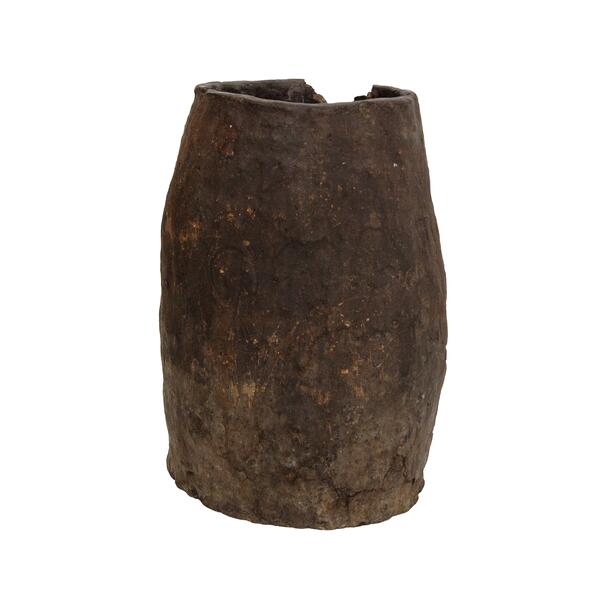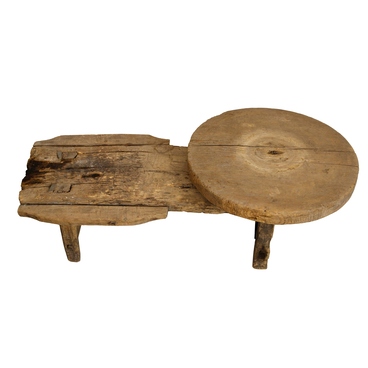This pot was made in the early twentieth century in the village of Novaya Pyrma, Saransk district, Penza Province. The vessel is made by hand, without a potter’s wheel, in the technique of coiling. The pot is slightly narrowed at both the top and bottom. The uneven walls of the pot are roughly smoothed, and large chipping can be seen on the upper edge. A mark of ownership is carved on the wet clay on the wall: a circle with two spurs.
Similar crockery was made in the villages of Kochkurovo district of the Mordovian Republic, inhabited by the Mordva-Erzya (as one of the Mordovian ethnic groups is called): Kochkurovo, Novaya Pyrma, Tavla. Extraction, delivery, preparation of clay, shaping and firing of pots on this territory was traditionally done exclusively by women.
Having set the workpiece on a primitive potter’s wheel, the craftswoman rolled a long coil of clay and flattened it as wide as about 4 centimeters. She stuck the resulting band on the workpiece, attached the next one to it and thus got the desired height of the pot.
She could make up to 10 pots in one working day. The drying of pottery lasted from 1 to 2 months, after which it could be fired in the Russian oven. For a week, the pots were “fired” on the bake stone (the lower surface of the stove), as the family cooked food. After such pre-firing they were put on the side of the birch logs, stacked in the form of “a well”. Eight medium-sized pots or two large korchagas (large pots) fit into the oven.
Fire and temperature first made the clay black from the smoke, then it turned white from the heat, and finally it became translucent red. This was the indicator that the product was ready. When the pot was hardened, it was taken out of the oven and either poured over with flour water (from rye flour), or put in a tub with it for 10-15 minutes. If the pot was well tempered, it did not burst from the sudden change in temperature.
The hand-made pottery was massive and heavy but very strong. Its service life was 20-50 years, and in some families it was used for more than one generation.
Some pots in the museum collection bear property marks — clan marks that also carried a sacred, “protective” meaning. As a rule, the marks had their own names: “hare ears”, “ram’s horns”, “eagle’s tail” and others.
Similar crockery was made in the villages of Kochkurovo district of the Mordovian Republic, inhabited by the Mordva-Erzya (as one of the Mordovian ethnic groups is called): Kochkurovo, Novaya Pyrma, Tavla. Extraction, delivery, preparation of clay, shaping and firing of pots on this territory was traditionally done exclusively by women.
Having set the workpiece on a primitive potter’s wheel, the craftswoman rolled a long coil of clay and flattened it as wide as about 4 centimeters. She stuck the resulting band on the workpiece, attached the next one to it and thus got the desired height of the pot.
She could make up to 10 pots in one working day. The drying of pottery lasted from 1 to 2 months, after which it could be fired in the Russian oven. For a week, the pots were “fired” on the bake stone (the lower surface of the stove), as the family cooked food. After such pre-firing they were put on the side of the birch logs, stacked in the form of “a well”. Eight medium-sized pots or two large korchagas (large pots) fit into the oven.
Fire and temperature first made the clay black from the smoke, then it turned white from the heat, and finally it became translucent red. This was the indicator that the product was ready. When the pot was hardened, it was taken out of the oven and either poured over with flour water (from rye flour), or put in a tub with it for 10-15 minutes. If the pot was well tempered, it did not burst from the sudden change in temperature.
The hand-made pottery was massive and heavy but very strong. Its service life was 20-50 years, and in some families it was used for more than one generation.
Some pots in the museum collection bear property marks — clan marks that also carried a sacred, “protective” meaning. As a rule, the marks had their own names: “hare ears”, “ram’s horns”, “eagle’s tail” and others.



